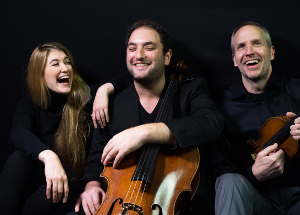Music Director Dmitri Sitkovetsky and the Greensboro Symphony paid tribute to the orchestra’s many connections with the University of North Carolina at Greensboro, from its early origins to the many orchestra members who are either faculty members, students, or alumni. The vocal soloist, Mari Moriya, was awarded first place in the 2006 Charles A. Lynam Vocal Competition at the university and is building an impressive resume of roles with major opera companies.
From the alert attacks and tight ensemble with which the orchestra opened Don Juan, Op. 20 by Richard Strauss, it was clear the musicians had not let cobwebs or dust accumulate on their “chops” over the summer break. Sitkovetsky maintained a good balance between his strings and brasses as he chose apt tempos and used phrasing that brought out the key dramatic points of this tone poem based on a scenario by Nikolaus Lenau. Principal players were on the top of their form with the presentation of the two themes, the first by the tender, longing sighs of Concertmaster John Fadial’s violin, then the second theme of pursuit played by the horns, led by Robert Campbell. Throughout all four movements, the woodwinds solos were excellent and beautifully blended during ensemble playing. Among the players Sitkovetsky asked to stand and share the prolonged applause were trumpeter Anita Cirba, clarinetist Kelly Burke, and oboist Mary Ashley Barret.
Coloratura soprano Mari Moriya has already chalked up some impressive career highlights including her Metropolitan Opera debut last season as the Queen of the Night in the acclaimed Julie Taymor production of Mozart’s Die Zauberflöte. She represented her native Japan at the 2007 Cardiff Singer of the World Competition. In response to a question during the post-concert Meet the Artists session, Moriya and Sitkovetsky explained the meaning of “coloratura” as it is applied to all vocal categories from soprano to bass. It is the ability to execute florid and rapid ornamental runs cleanly and precisely. Moriya did this in spades in the Queen of the Night’s two big arias: “O zittre nicht, mein lieber Sohn,” which portrays her as a wronged mother, and “Der Hölle Rache,” which reveals her to be a vindictive harpy. Moriya’s diction was excellent, giving the German consonants and endings their due without breaking the musical line. Her intonation was laser-like as she hit every note, no matter how fast she took them. Equally impressive was the seamless transition of her voice between her chest register to her head register in rapid succession. Sitkovetsky created a good, stylish accompaniment. The close co-ordination between a run of Moriya’s high notes and those of the flutes was memorable.
Sitkovetsky brought a strong sense of inevitability and an over-arching sense of line to a solid interpretation of Brahms Symphony No. 2 in D Major, Op. 73. His unhurried opening tempos gave the music plenty of room to breathe naturally as the forward flow built up inexorably. Balances between the brasses and the strings were fine. His antiphonal seating of the two violin sections, right and left of the podium, helped make musical lines more clear. Only when one section of violins played a higher lying passage alone did one miss having a few more stands (a problem with all orchestras in the state). The warm, rich sound of the cellos was welcome as they opened the second movement alone. Woodwinds were strongly characterized and brasses were on their best behavior. The horns were glorious throughout. The wonderfully pungent low notes of the trombones, just near the end of the finale, were a delight.












